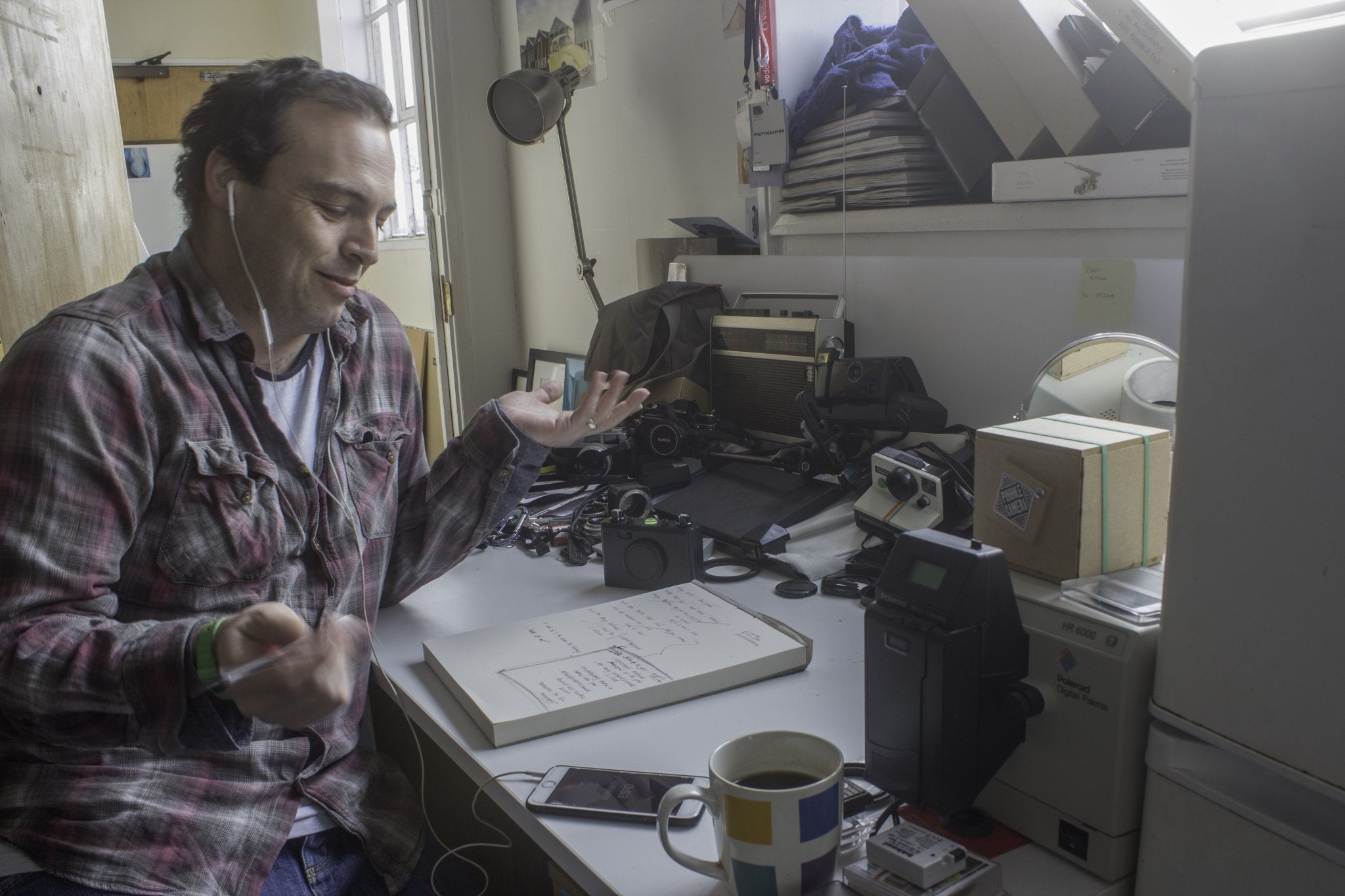Black Friday 2025 has landed at Analogue Wonderland, bringing some of our biggest film photography deals of the year - from discounted film and cameras to money-saving WonderLab processing offers, exclusive bundles, and festive specials available for a limited time only. Grab a great deal while stocks last!

Starting a Film Photography Podcast: The Birth of 'Soot and Whitewash'
By Paul McKay
Oh my we are in for a treat today. Neil Piper has written the story of starting his own film photography podcast! Neil is the host of the 'Soot and Whitewash' podcast, a pinhole wizard, and is also currently studying for a Masters at Norwich University of the Arts with Elliot Knott. Neil, teach us...
Stage One: Guest
The idea of a podcast had been sitting, firmly wedged in the back of my mind for quite a while. I was already listening to many podcasts about analogue photography. The FPP, Sunny 16, Negative Positives, The Lensless Podcast…and all of the while I was listening to these shows and in almost every show in which they were discussing something that I knew about I’d be thinking “yeah that’s true, that’s true, oh hadn’t thought of that - but you didn’t mention this…” I was thinking that maybe I could have a go.
Listening to Mike Gutterman of Negative Positives say in his broad Kentucky accent “come on everybody I need to hear more podcasts, if you’ve got something to say then why don’t you start your own show!” I thought “well yeah, why not?” But I couldn’t quite bring myself to record that first episode. I didn’t have a mic. I didn’t have any audio recording or editing software? I don’t have the spare cash to drop on equipment ‘needed’ for something that I wasn’t even sure that I wanted to do.
In June 2018 Corey Cannon asked me if I’d make a guest appearance along with Alex Purcell and co-host Andrew Bartram on a future episode of The Lensless Podcast. I shoot a lot of pinhole and was assured that it would be just like being on a conference call – although on this conference call we’d get to chat about cool stuff about pinhole photography rather than your usual boring work conference call!

In late June it was confirmed that I’d be on the next recording of Lensless…and I was nervous as hell. I knew that I’d have to answer that horrible first question – “Hey Neil why don’t you take a minute to tell the listeners about your practice, and how you got into photography and pinhole…?”
Why? Because I’m nervous enough about even talking about something that I know quite a bit about, let along being recorded whilst talking about my own photographic practice…I find that hard enough to explain at the best of times…! Anyway, it happened, I don’t think I ummed and erred too much, and ultimately it was fine – as they said, just four guys hanging out ‘virtually,’ talking about a subject that we all know and love.
Stage Two: Co-Host
I then got a taste for it, but still couldn’t commit. There was something still niggling me about the idea of basically sitting down and talking to myself about stuff that I already knew. Then one evening I got a text from Corey saying that Andrew was on holiday and he would like me to co-host the next show. Crap…I really wanted to do it but those nerves came straight back! But I did it, and of course it was fine.
Corey and I just sat back and chatted all things pinhole for just over an hour. It was released, the feedback was positive and I decided that yes this was for me but I still didn’t have the equipment - but then it occurred to me that I didn’t need this extra equipment! I had recorded with the Lensless guys with nothing more than an iPhone, the microphone that’s attached to the standard headphones, and an app called Anchor, so that’s how I’d do mine.

Stage 3: Record
So I did it, I sat down in my studio, just me, the Anchor app on my iPhone and a microphone dangling next to my mouth and I talked. I recorded two episodes that evening of what would become Soot and Whitewash – the first being an introduction to me and my photographic practice (it was awful, really, please don’t bother with that one!) and the other being a walk through and review of a beta version of Hamish Gill’s Pixl-latr that he very kindly sent me to test.
And that’s really how it started.
Its a simple thing to do and I’d strongly encourage any of you to do the same if you feel that you have something unique to say about any subject – especially film photography!
So you’ve decided that you’d like to do the same? Great. What do you need? Well, I already told you…not a whole lot. If you are listening to the FPP (and if not, why not?) you’ll know that Mike spends time editing the whole show together, sound effects, chats, vintage advertisements etc, but this doesn’t need to be the case with yours. It can be as simple as follows:
- Download the Anchor app on your phone
- Dig out those headphones that came with your phone
- Open the app and register an account
- Hit the big + button, then hit Record
- Start talking about something you find interesting!
That’s really it.

Now I realise that this is now going to start sounding like a commercial for Anchor but it's really not. I’m just going to talk about my experience of creating a podcast and Anchor is simply all I know.
Stage 4: Publish
So you’ve recorded your first segment within the Anchor app, what’s next? Well is that all you have to say for the moment? If yes, then publish it dude! Actually that’s not quite true. The first thing you want to do is have a listen back to what you’ve just recorded. Make sure that you are sounding clear and your speaking volume is loud enough. My first few episodes were plagued with bad audio quality so now I make sure that I hold the mic close to my mouth when I’m recording.

Next? Listen back to it again. This bit is really important. Is what you’re talking about something different? Have you genuinely got something new to say? Have you talked about your thoughts about that new piece of kit that’s just hit Kickstarter? Or are you simply regurgitating the same information that you heard Mike and the gang chatting about on the last FPP show? Did Graeme, Ade and Rachael on Sunny 16 already make that same point about those new rumours about a long dead film emulsion…?
Remember that there is very little - if any – point in simply repeating what other shows are already talking about. Your show should reflect you and your own personal views regarding what you’re talking about.
Top Tips
So you’ve listened back, maybe a couple of times, and confirmed that you do indeed do have something interesting to say that builds upon what everybody else is talking about, or is something completely new altogether. Got something else you want to talk about? Then don’t publish that first segment yet and just repeat the process. Record your next segment. In my shows I tend to have anywhere between about three and five topics that I want to talk about. That might be a new product that is in the news. It could be a camera review. It could be walking the listeners through my home C-41 developing process. Once you have recorded everything that you want to then you can put in some show notes if you want to.

I tend to sum up everything that I’ve talked about in the show – without giving away any potential spoilers - link in anybody that I have spoke about – instagram handles, website addresses etc and then put mine and the shows contact details in.
When I started the show I decided that I didn’t want to flood anybody who cared to listen with too much new stuff, so I repeatedly said that the show would be released ‘as and when’ – as in as and when I had something I found interesting to talk about but this quickly fell through and I was releasing a show a week! I never had any feedback saying that the show was too frequent; in fact all feedback about content and frequency was surprisingly positive!
And that’s about it really. That’s why I started, that’s the secrets behind how I record Soot and Whitewash and release it – Anchor does it all for me – I just have to find something interesting to talk about each week!

Neil - thank you. Readers, you can follow Neil on the Soot and Whitewash podcast, as well as on Instagram where you can find lots more of his jaw-dropping pinhole photography.
Ready to dive in?
Keep Reading
View all
Christmas 2025: Shipping & Opening Hours
Christmas 2025 is fast approaching! To make sure your analogue goodies arrive in time, take note of our last shipping dates, plus opening and operating hours over the festive season. We've got everything you need to gift the magic of film photography this Christmas!

Film Photography Christmas Gift Guide 2025: Analogue Wonderland
Capture the magic of Christmas with film - no filters needed. Our 2025 Film Photography Christmas Gift Guide 2025 is packed with thoughtful presents for every type of shooter, from curious beginners to seasoned photographers. Discover film stocks, cameras, and creative accessories that will make this festive season truly memorable.
Subscribe to our newsletter 💌
Sign up for our newsletter to stay up to date on film photography news, sales and events:
Free Tracked Shipping
On all UK orders over £50
Passion For Film
An unbeatable range and an on-site lab
Our Customers Trust Us
Thousands of independent 5* reviews
All Deliveries are Carbon Neutral
Independently audited and verified by Planet
- Opens in a new window.





2 Comments -
Rachel • -
matt Jones •
Great article! Congratulations on getting the show up and running (and continuing!) Love your pinhole work. 😊
It’s a good podcast, but wow what about that last baby in a pram image, spectacular :)